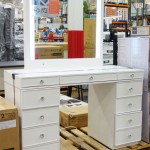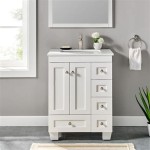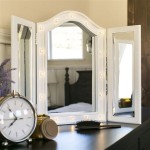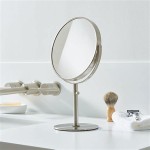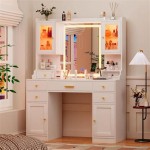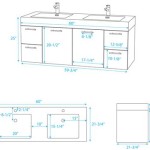```html
How Wide Should a Mirror Be Over a Vanity?
Selecting the correct size for a bathroom mirror above a vanity is a crucial aspect of bathroom design, impacting both aesthetics and functionality. The mirror should complement the vanity in size and shape, creating a visually balanced and practical space. Determining the optimal width involves considering factors such as the vanity's dimensions, the overall bathroom size, lighting placement, and personal preferences.
A poorly sized mirror can throw off the entire bathroom's design, making the space feel unbalanced or cramped. Conversely, a well-chosen mirror can enhance the perceived size of the room, improve lighting, and provide a more comfortable and efficient grooming experience. This article explores the key considerations involved in determining the ideal width for a mirror over a vanity, providing a comprehensive guide to achieving a harmonious and functional bathroom design.
Vanity Width as the Primary Guide
The width of the vanity serves as the primary reference point when selecting a mirror size. A general rule of thumb is that the mirror should be approximately the same width as the vanity or slightly narrower. This approach ensures a visually balanced and proportionate design.
For a single vanity, the mirror's width should ideally be within a few inches of the vanity's width. For instance, if a vanity is 30 inches wide, a mirror between 24 and 30 inches would be a suitable choice. This range allows for a visually cohesive look, preventing the mirror from overpowering the vanity or appearing too small in comparison.
Double vanities present a slightly different scenario. There are two common approaches: using a single, large mirror spanning the entire width of both vanities or using separate mirrors above each vanity. If opting for a single mirror, it should ideally be the same width as the combined width of the vanities. However, this approach can sometimes look overwhelming in smaller bathrooms. Another option involves a single mirror that spans most of the combined vanity width, leaving a small space on either side.
Using two separate mirrors above each vanity allows for individualization and a more personalized design. In this case, each mirror should be approximately the same width as its corresponding vanity basin. This approach can also be advantageous if each user has different height preferences, as the mirrors can be mounted at slightly different levels.
Consider the style of the vanity when deciding on the mirror width. A minimalist vanity might benefit from a mirror that is exactly the same width, creating a clean and streamlined look. A more ornate vanity, on the other hand, may benefit from a slightly narrower mirror, allowing the vanity's details to remain the focal point.
Bathroom Size and Overall Proportions
While the vanity width is the primary guide, the overall size of the bathroom also plays a significant role in determining the appropriate mirror width. In smaller bathrooms, a large mirror can create the illusion of more space, making the room feel less cramped and more open. A wide mirror reflects more light and visually expands the room's dimensions.
However, even in a small bathroom, it's crucial to avoid a mirror that completely overwhelms the vanity. A mirror that is significantly wider than the vanity can disrupt the visual balance and make the vanity appear disproportionately small. Carefully consider the overall proportions of the bathroom and ensure that the mirror complements the other elements in the space.
In larger bathrooms, there is typically more flexibility in terms of mirror size. A wider mirror can create a more luxurious and spa-like atmosphere. However, it is still important to maintain a sense of proportion. A mirror that is too wide in relation to the vanity can make the space feel less cohesive and well-designed.
Consider the height of the ceiling when selecting a mirror. In bathrooms with high ceilings, a taller mirror can help to fill the vertical space and create a more balanced look. In bathrooms with lower ceilings, a shorter mirror may be more appropriate to avoid overwhelming the space.
The placement of other bathroom fixtures, such as the toilet and shower, can also influence the optimal mirror width. Ensure that the mirror is positioned in a way that complements the surrounding elements and creates a harmonious overall design.
Lighting and Functionality
The placement of lighting fixtures is an important consideration when determining the ideal mirror width. The mirror should be wide enough to effectively reflect light and provide adequate illumination for grooming tasks such as shaving and applying makeup. Insufficient lighting can create shadows and make it difficult to perform these tasks effectively.
Sconces or vanity lights are commonly placed on either side of the mirror to provide even illumination. In this case, the mirror should be wide enough to allow for adequate spacing between the lights and the edges of the mirror. Ideally, the lights should be positioned at eye level to provide the most flattering and effective illumination.
If using a single light fixture above the mirror, the mirror's width should be sufficient to evenly distribute the light across the face. A mirror that is too narrow may create harsh shadows and uneven illumination. Consider the type and intensity of the light fixture when determining the appropriate mirror width.
In addition to lighting, consider the functionality of the mirror. Do you need a mirror that provides a wide field of view for tasks such as shaving or applying makeup? Do you want a mirror that is large enough to reflect your entire upper body? The answers to these questions will help you determine the optimal mirror width.
Consider integrating features into the mirror, such as built-in lighting or magnification. These features can enhance the functionality of the mirror and improve the overall grooming experience. Mirrors with integrated lighting often require specific dimensions to accommodate the lighting elements.
Framed mirrors can add a decorative element to the bathroom and help to define the mirror's boundaries. The frame's width should be taken into account when determining the overall mirror width. A thick frame can make the mirror appear larger, while a thin frame can create a more minimalist look.
Ultimately, the ideal mirror width over a vanity is a balance of aesthetics, functionality, and personal preference. The considerations outlined above provide a framework for making an informed decision that results in a well-designed and functional bathroom space. Careful planning and attention to detail will ensure that the mirror complements the vanity and enhances the overall bathroom design.
```
Bathroom Mirror Size Calculator

How Big Should A Mirror Be Over Vanity Ledmyplace

Sizing The Mirror Above Your Bathroom Vanity Dengarden

Bathroom Mirror Size Calculator

Sizing The Mirror Above Your Bathroom Vanity Dengarden

How To Pick And Hang The Perfect Bathroom Mirror Roomhints

How To Choose The Best Size Mirror Olde Good Things

How To Choose The Perfect Vanity Mirror Ryan S All Glass

How High Should You Hang The Mirror In A Bathroom With Photos Design Morsels

How Big Should A Bathroom Vanity Mirror Be
